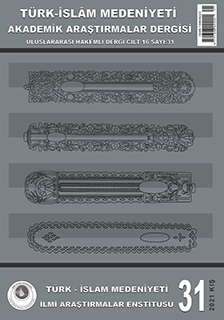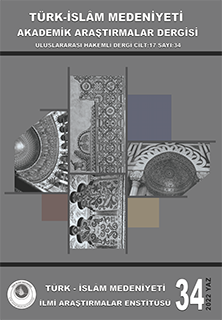Chicago Üniversitesi Orta Doğu Dokümantasyon Merkezi Memlûk Araştırmaları Hakkında Bir Değerlendirme
Anahtar Kelimeler:
Memlûk Araştırmaları, Memlûklar, Makrîzî, Mısır, SuriyeÖzet
İlk yayınını 1997 yılında gerçekleştirmiş olan Chicago Üniversitesi Orta Doğu Dokümantasyon Merkezi Memlûk Araştırmaları Dergisinde (Mamluk Studies Review-MSR) yalnızca Memlûk araştırmaları ile ilgili yazılar yayına kabul edilmektedir. Memlûkların siyasi, iktisadi, içtimai ve ilmi faaliyetlerini konu edinen çalışmalar dışında Memlûklar ile ilgili neşredilmiş kayda değer kitapların tanıtım yazılarına da dergide yer verilir. Bu çalışmada MSR hakkında bilgiler sunulduktan sonra ilk yayın faaliyetinden günümüze kadar takip eden yıllarda çıkmış kayda değer çalışmalar tanıtılması amaçlanmıştır. Türk Tarihinin önemli bir safhasını teşkil etmesinin yanında, Memlûklar devrinde inkişaf gösteren ilmi faaliyetler, iktisat tarihinin konusuna giren pek çok mevzu ve devletin kültür tarihine inhisar eden hususlar ile ilgili çalışmalar ülkemizde yeterli değildir. Bu bağlamda Memlûk Türk Devleti tarihi ile ilgili birçok meselenin irdelenmesi gerekmektedir. Kurumsal olarak MSR’nin yanı sıra Bonn Üniversitesi bünyesinde gerçekleştirilen Memlûk araştırmaları da dikkate alındığın da bu çalışma sahasının batı dünyasında ne kadar önemsendiği rahatlıkla gözlenebilir.
Referanslar
Abouseif, D. B. (1994). Egypt’s Adjustment to Ottoman Rule, Leiden: New York: Köln.
Abouseif, D. B. (1999). Beauty in Arabic Culture, Princeton.
Abouseif, D. B. (2007). Cairo of the Mamluks: A History of Architecture and its Culture, Cairo and London.
Abouseif, D. B. (2014). Practicing Diplomacy in the Mamluk Sultanate: Gifts and Material Culture in the Medieval Islamic World, London. Abouseif, D. B. (1997). The Mahmal Tradition and the Pilgrimage of the Ladies of the Mamluk Court. Mamluk Studies Review, v.1, s.87-96.
Abouseif, D. B. (1998). Sultan Qaytbay's Foundation in Medina, the Madrasah, the Ribat and the Dashishah. Mamluk Studies Review, v.2, s. 61-72.
Abouseif, D. B. (2002). Sultan al-Ghawri and the Arts. Mamluk Studies Review, v.6, s. 71-94.
Amitai, R. (1995). Mongols and Mamluks: The Mamluk-Ilkhanid War, 1260- 1281, Cambridge University Press, New York.
Amitai, R. (1999). David Ayalon, 1914-1998 (obituary). Mamluk Studies Review, v.3.
Antrim, Z. (2014-15). The Politics of Place in the Works of Ibn Taymiyah and Ibn Fadl Allah al-'Umari. Mamluk Studies Review, v. 18, s. 91-111. Berker, H. (2016). Purchasing a Slave in Fourteenth-Century Cairo: Ibn alAkfani’s Book of Observation and Inspection in the Examination of Slaves. Mamluk Studies Review, v. 19, s. 1-23.
Buturovic, A. (2003). The Shadow Play in Mamluk Egypt: The Genre and Its Cultural Implications. Mamluk Studies Review, v.7/1, s.149-176. Clifford, W. W. (1997). Ubi Sumus? Social Theory and Mamluk Studies. Mamluk Studies Review, v.1.
Conermann, S. (2000). Ulrich Haarmann, 1942-1999 (obituary). Mamluk Studies Review, v.4, s. 1-25.
Conermann, S., Saghbini, S. (2002). Awlad al-Nas as Founders of Pious Endowments: The Waqfiyah of Yahya ibn Tughan al-Hasani of the Year 870/1465. Mamluk Studies Review, v.6, s. 21-50.
Firanescu, D. R. (2018). Medieval Arabic Islam and the Culture of Gender: Feminine Voices in al-Suyūṭī’s Literature on Sex and Marriage. Mamluk Studies Review, v. 21, s. 69.86.
Fuess, A. (2001). Rotting Ships and Razed Harbors: The Naval Policy of the Mamluks. Mamluk Studies Review, v.5, (2001), s. 45-71.
Guo, L. (1998). Early Mamluk Syrian Historiography: Al-Yunini’s Dhayl Mir’at al Zaman, Leiden: Brill.
Guo, L. (2004). Commerce, Culture, and Community in a Red Sea Port in the Thirteenth Century: The Arabic documents of Quseir, Leiden: Brill. Guo, L. (1997). Mamluk Historiographic Studies: The State of the Art. Mamluk Studies Review, v.1, s. 15-43.
Haarmann, U. (2001). The Mamluk System of Rule in the Eyes of Western Travelers. Mamluk Studies Review, v.5, s. 1-24.
Humphreys, R. S. (1977). From Saladin to the Mongols: the Ayyubids of Damascus, 1193-1260, Islamic History: A Framework for Inquiry, State University of New York Press.
Humphreys, R. S. (1991). Islamic History: A Framework for Inquiry, Princeton University Press. Humphreys, R. S. (1998). Ayyubids, Mamluks, and the Latin East in the Thirteenth Century. Mamluk Studies Review, v.2, s. 1-17.
Irwin, R. (2000). Under Western Eyes: A History of Mamluk Studies. Mamluk Studies Review, v.4, s. 27-51.
Levanoni, A. (2005). Food and Cooking during the Mamluk Era: Social and Political Implications. Mamluk Studies Review, v.9/2, s. 201-222. Levanoni, A. (2010). Who Were the “Salt of the Earth” in Fifteenth-Century Egypt? Mamluk Studies Review, v. 14, s.63-83.
Levanoni, A. (2011). The Halqah in the Mamluk Army: Why Was it Not Dissolved When It Reached Its Nadir?”, Mamluk Studies Review, v. 15, s. 3765.
Little, Donald P. (1987). Documents as a Source of Mamluk History. Mamluk Studies Review, v.1, s. 1-13.
Little, Donald P. (1998). Documents Related to the Estates of a Merchant and His Wife in Late Fourteenth Century Jerusalem. Mamluk Studies Review, v.2, s. 93-192.
Little, Donald P. (2002). Notes on Mamluk Madrasahs. Mamluk Studies Review, v.6, s. 9-20.
Mazor, A. (2014-15). The “Mansuriyah Legacy”: The Mansuri Amirs, Their Mamluks, and Their Descendants during al-Nasir Muhammad’s Third Reign and After. Mamluk Studies Review, v. 18, s. 1-56.
Meloy, John, L. (2005). Economic Intervention and the Political Economy of the Mamluk State under al-Ashraf Barsbay. Mamluk Studies Review, v.9/2, s. 85103.
Myrne, P. (2018). Women and Men in al-Suyūṭī’s Guides to Sex and Marriage. Mamluk Studies Review, v. 21, s. 47-67.
Ouerfelli, M. (2005). Tsugitaka Sato, Sugar in the Social life of Medieval Islam. Islamic Area Studies. vol. 1 (Leiden-Boston: Brill, 2015). Pp. xii, 232. Mamluk Studies Review, v. 20, s. 247-251.
Petry, Carl F. (1993). Twilight of Majesty: The Reigns of the Mamluk Sultans alAshraf Qaytbay and Qansuh al-Ghawri in Egypt. Washington UniversityPress.
Petry, Carl F. (1991). The Civilian Elite of Cairo in the Later Middle Ages, Princeton University Press.
Petry, Carl F. (1994). Protectors or Praetorians? The Last Mamluk Sultans and Egypt’s Waning as a Great Power, New York State University Press.
Petry, Carl F. (1998). A Geniza for Mamluk Studies? Charitable Trust (Waqf) Documents as a Source for Economic and Social History. Mamluk Studies Review, v.2, s.51-60.
Rahim, Ahmad H. (2013). Obituary: David C. Reisman (1969–2011). Mamluk Studies Review, v. 17, (2013), s. 1-4.
Rapoport, Y. (2007). Women and Gender in Mamluk Society: An Overview, Mamluk Studies Review, v.11/2, s. 1-47.
Rapoport, Y. (2012). Royal Justice and Religious Law: Siyasah and Shari'ah under the Mamluks. Mamluk Studies Review, v. 16, s. 71-102.
Sarraf, S. (2004). Mamluk Furusiyah Literature and Its Antecedents. Mamluk Studies Review, v.8/1, s. 141-200.
Schultz, W. (1999). Mamluk Monetary History: A Review Essay. Mamluk Studies Review, v.3, s. 183-205.
Sopracasa, A. (2016). Venetian Merchants and Alexandrian Officials (End of the Fifteenth–Beginning of the Sixteenth Century). Mamluk Studies Review, v. 19, s.91-100.
Tsugitaka, S. (2004). Sugar in the Economic Life of Mamluk Egypt. Mamluk Studies Review, v.8/2, s. 87-107.
Tsugitaka, S. (2005). Mamluk Studies in Japan: Retrospect and Prospect. Mamluk Studies Review, v.10/1, s. 1.27.
Walker, Bethany J. (2010). From Ceramics to Social Theory: Reflections on Mamluk Archaeology Today. Mamluk Studies Review, v. 14, s. 109-157.
Walker, B., Laparidou, S., Hansen, A., Corbino, C. (2017). Did the Mamluks Have an Environmental Sense? Natural Resource Management in Syrian Villages. Mamluk Studies Review, v. 20, s.167-245.
Woods, E. (1999). The Aqquyunlu: Clan, Confederation, Empire, revised and expanded edition, Salt Lake City.
İndir
Yayınlanmış
Nasıl Atıf Yapılır
Sayı
Bölüm
Lisans

Bu çalışma Creative Commons Attribution-NonCommercial 4.0 International License ile lisanslanmıştır.







